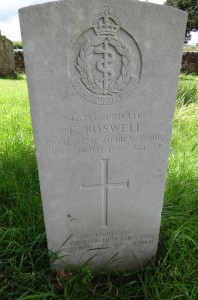 Regiment: Royal Army Medical Corps
Regiment: Royal Army Medical Corps
Service No: 48726
Date & place of birth: 2nd qtr. 1883 in Cocking, Sussex
Date & place of death: 2 August 1920 (aged 37) in Heyshott, Sussex
Ernest Boswell served in the Royal Army Medical Corps. He survived the fighting on the Western Front, but died after the war from the effects of trench fever; he is buried in Heyshott churchyard.
Family background
Ernest was the son of Henry Boswell (1839–1921), an agricultural labourer from Cocking and Sarah Ann née Fossey (1837–1921) from Harting, who married in West Lavington in April 1857. According to census records Sarah gave birth to at least fourteen children.
When Ernest was born in the spring of 1883, his parents were in their early forties and some older siblings had already left home. Of the remaining family, he had five older brothers who were already working in agriculture, in addition to another brother Walter, who was still very young. The youngest child, a girl called Annie was born two years after Ernest. At this time they lived at Old House, Cocking. By 1901 the family had moved to Cocking Causeway.
In 1904, aged 21, Ernest married Rose Lockyear (1884-1964). At the time of the 1911 census, they were living in Little Hoyle Farm Cottage, Heyshott and Ernest worked as a Cowman Labourer. They had three children, Nellie (5), Harry (4) and Esme who was 3 years old. It is probable that a further three sons and a daughter were born prior to him joining the military, Ernest 1911, female child 1912, Thomas 1913 and William 1915 but the mother’s maiden name for these births is given as Lockyer, so this might possibly not have been Rose. However, of these children only Ernest survived infancy.
Military service
Ernest decided to serve his country by enlisting in the Royal Army Medical Corps. The RAMC is a specialist corps in the British Army, which provides medical services to all British Army personnel and their families in war and in peace. The RAMC was not a fighting force but members saw the full horror of the war. The officers and men performed their duties unarmed and the Corps lost no less than 6,873 personnel during WW1. It is difficult to locate where individual RAMC personnel served during this time, as documentation shows that they served but does not give details of the actual medical unit they served in. However from his Medal Roll Index Card we know that Ernest served in France from 6 December 1915.
Death and commemoration
Ernest returned from France at the end of hostilities but died aged 37, of sickness on 2 August 1920 at home in Heyshott. His death certificate gives the cause of death as “morbus cordis” (heart disease) and trench fever. Trench fever was fairly common amongst soldiers in the war, with over a quarter of British troops experiencing it at least once. It was transmitted via the bites of body lice and the symptoms were headaches, skin rashes, inflamed eyes and leg pains, which generally lasted about five or six days. Lethal cases were rare, but in a few cases, persistent fever could lead to heart failure.
The death certificate gives his occupation as “general labourer and army pensioner”; the death was registered by his wife’s uncle, William Henry Lockyear, whose son William had died in Egypt in 1917 and is also commemorated on the Heyshott war memorial.
Ernest’s death is commemorated alongside other fallen comrades on the Heyshott Memorial window and his gravestone is near three other soldiers from the village who returned from The Great War but who died shortly afterwards.
As well as the 1914/15 Star, Ernest was awarded the British War Medal and the Victory Medal.
Subsequent family history
At the time of Ernest’s death, his parents were still alive but they both died the following year, 1921. Rose and the family were living at Newells Cottage, Heyshott. Her eldest child, Nellie died in 1922 at the age of 16. In the first quarter of 1923, Rose re-married, to Frederick R Baker from Ambersham, and continued to live in the Midhurst area until her death in 1964.
Harry married Jessamine Cook in 1936 and had a daughter Iris born in Midhurst in 1938. Iris married William Lovejoy in 1964 and her death was recorded in Chichester in July 2000. Esme appears to have married a Thomas Vincent in East Preston in 1928 but it is not possible to trace her after this. Ernest does not appear to have married but his death is registered in Chichester in 1975.
Ernest’s elder brother, Arthur, born 1877, enlisted in the Royal Marine Light Infantry in September 1894. At the 1901 census, Arthur was serving on board HMS Firefly, but was subsequently transferred to the protected cruiser, HMS Highflier, based in the Caribbean. On 10 July 1917, Highflyer provided the escort for convoy HS 1, the first convoy to sail from Canada to Britain.
On 6 December 1917, she was in Halifax Nova Scotia, when the French ammunition ship SS Mont-Blanc collided with the Norwegian ship, SS Imo. A fire aboard the French ship ignited her cargo of wet and dry picric acid, TNT, and guncotton. The resultant enormous explosion destroyed much of the city of Halifax. Highflyer launched a whaleboat before the explosion to investigate the fire aboard Mont-Blanc; the ship exploded before they reached her, killing nine of ten men in the boat. Arthur was on shore leave at the time of the explosion, but rushed back to his ship and was caught up in the blast, and was hit by flying glass, losing the sight in his left eye. In later years, Arthur wore an eye-patch and would tease his grandchildren that he was a pirate.
Arthur married Kathleen Jennings and the couple had four children.